Long-Term Review
“2024 Peugeot e-208 Long-Term Test with Giga Gears”
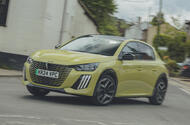 Electric hatchback arrives with at least four crucial questions to answer
Electric hatchback arrives with at least four crucial questions to answer
Why we’re running it: To get under the skin of a promising hatch and assess its tech in daily use
Month 1 - Specs
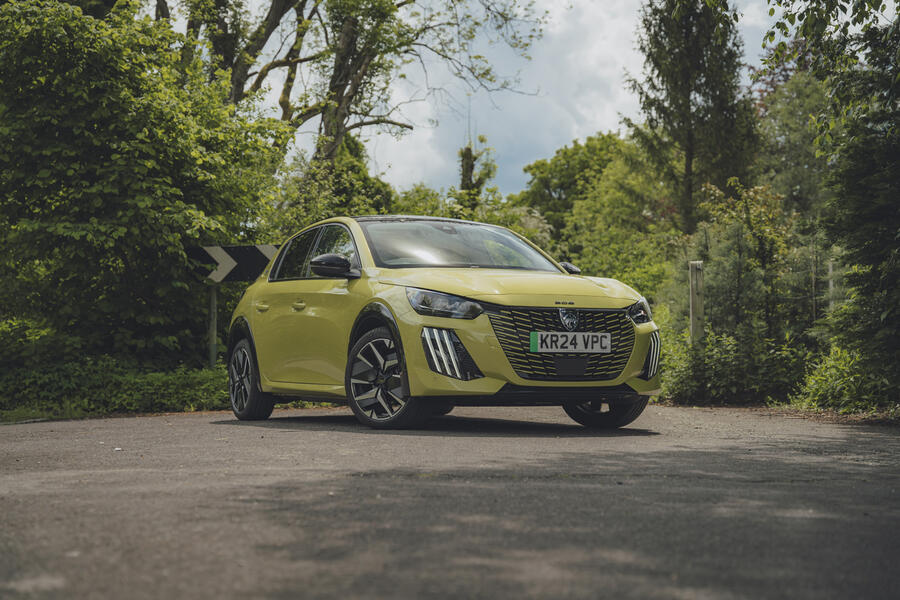
Life with a Peugeot e-208: Month 1
Welcoming the e-208 to the fleet
French carmakers have always done things a little differently. At various times they have tried - somewhat successfully to change the perception that a car needed to be a box on wheels.
Remember the shark-like Citroen DS, a car that made half-covered wheels cool, then the bonkers-looking Ami6 and, more recently, the daft Renault Avantime MPV At other times, they have tried less successfully - to reimagine what a car should be.
There was the Renault Project 900, a car that was built back to front (yes, really); the Voisin Biscooter, which looked more like a school project than a production car; and even the propeller-driven Leyat Helica, because who doesn't want a plane that doesn't fly?
We can't leave out the Renault Twizy and Citroen Ami electric two-seaters, created as alternative mobility vessels. The Ami in particular feels like it has been produced for French 14-year-olds who are fed up with cycling everywhere.
But sometimes they really do get it right, like with the super cheap Citroen 2CV, which did indeed transform the automotive industry by opening motoring to the masses. Down with the haute bourgeoisie, et tout ça.

More recently, Peugeot had a stab. It's not as dramatic as some, nor as symbolic as others, but it's no less transformative: the iCockpit. For those unaware, this positions the instrumentation above a smaller steering wheel to enable, as Peugeot says, better manoeuvrability and increased focus on the road.
Why is this relevant? Because it's the second generation of the Cockpit that I find in my new Peugeot e-208 - and since it concerns the primary way you interact with your car, it's rather important. The iCockpit has featured in all new Peugeot models since it was first launched in 2013.
I remember the original advert in 2012 and a real desire to try the new 208 with the smaller wheel. That finally happened in 2017, when I got given one: a hand-me-down from my dad, who was upgrading to a Honda Civic (FK generation).
And I really did love it. The set-up was brilliant: a small car that was already quite chuckable with a smaller wheel to make it even more chuckable. What fun. So when I received a call saying an e-208 was heading my way, I was not so silently thrilled.
I've had some really great times in my old 15-plate 208 - which my brother now runs as his daily - and I am excited to see if this new generation is just as smile-inducing. The new iCockpit generation, introduced in 2016 and upgraded in 2022, is definitely a move away from the original.
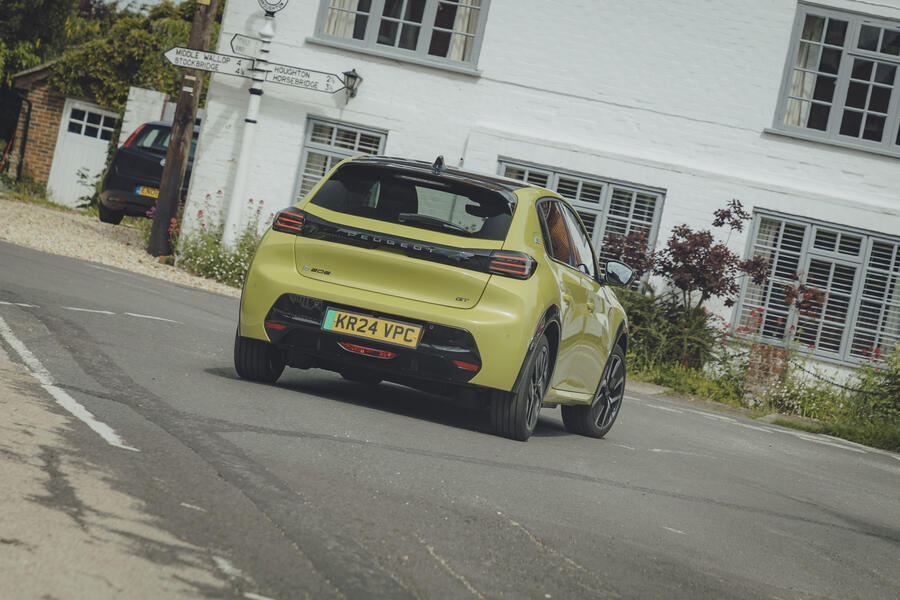
Gone are manual dials and the round steering wheel; in comes a customisable digital instrument cluster - which links up to the new i-Connect infotainment - and a wheel with a flat top and bottom.
First impressions are... mixed. It really is a slick bit of kit to use, but worries are looming over being able to adopt my preferred driving position: low seat, raised wheel. In this set-up, I'm finding the speedo is obscured by the steering wheel.
Unlike in the e-308, the screen isn't as customisable - for example, moving the speedo so it's higher on the screen - which is annoying. Lowering the wheel to counter this is also proving problematic because it restricts leg movement and easy pedal use. So this is an area to tweak and report back on, but I'm confident of a solution.
Anyway, beyond that, the key to a successful hatch is good looks. This has them. The updated second-generation 208 gets a more imposing face than its predecessor, with new tri-fang daytime-running lights and a broader front grille.
Our car also sports the Agueda Yellow exterior, which has proved to be a bit divisive among colleagues and friends, but I think it's great. It would be on my spec shortlist.
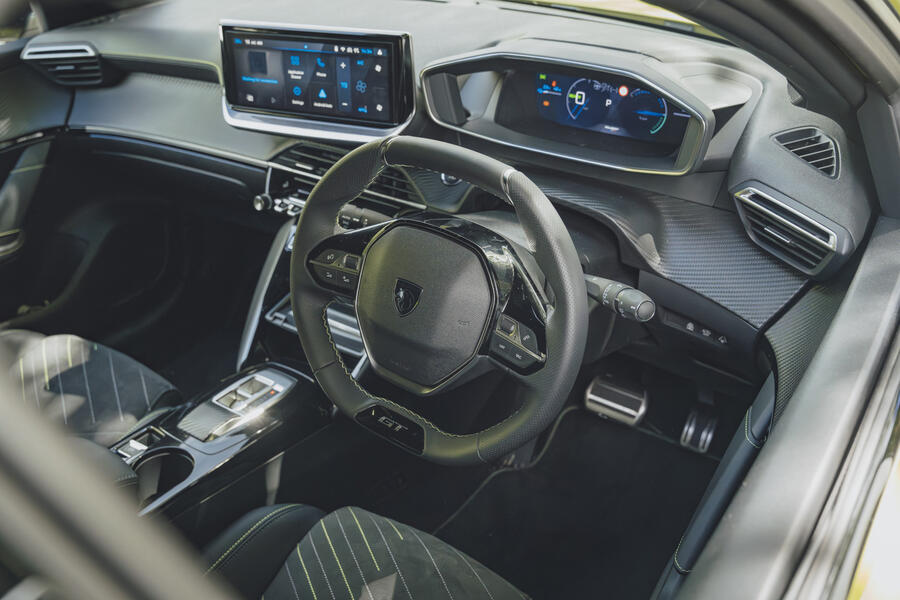
We also have GT trim, which, along with a new 10in touchscreen with wireless smartphone support and all-round sensors, adds 17in alloy wheels, a 3D instrument panel (which is quite funky) and 'dynamic' front seats.
Underneath, we have gone for the biggest, 54kWh (51kWh usable capacity) battery, which gives a WLTP range of around 250 miles. It can apparently be charged from 20-80% in less than 25 minutes by a 100kW charger.
Power is delivered by a new front-mounted 154bhp motor. For the eagled-eyed, this is indeed the same set-up as the new, bigger 308, the Vauxhall Corsa Electric and others in the Stellantis stable. So what are we looking to achieve during our time with the car?
First, to see why this French supermini was Europe's best-selling car in It finished sixth last year, but with only a 6% year-on-year drop, and it currently sits fifth.
Second, to see if small hatches like this - especially with an electric powerplant - have a future. In April (the most up-to-date figures at the time of writing), it was demand for superminis - including the 208, Renault Clio and Volkswagen Golf- rather than SUVs that increased the total of new car sales across Europe by 12%.
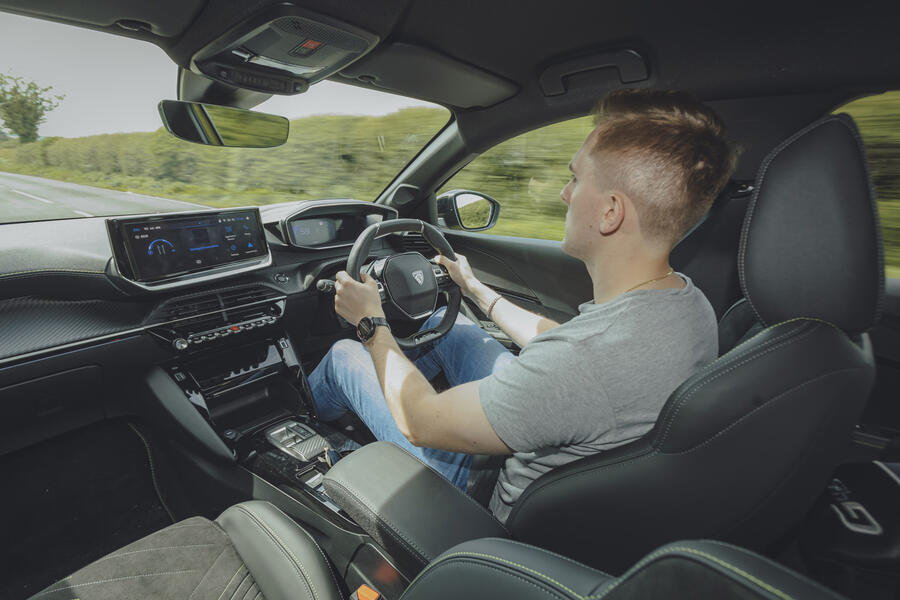
A rather tempting £251-per-month offer - in our car's spec - adds another pull to buyers.
Third, to find out whether the claimed range is achievable during the long-haul motorway driving I will mostly be undertaking, and if it isn't, whether the lower mileage it offers can be lived with.
And, finally, to ascertain if the iCockpit is as good as it once was. Colleagues who have experienced it previously aren't convinced it is and some are using that as a reason to write off the car completely. This will be a key question to answer.
So can this little electric hatchback live up to my nostalgic expectations? I hope so. During my short time with it so far, I'm already forming a bit of a connection. I'm excited to see what blossoms.
Second Opinion
I’m intrigued that Will got on with the first generation but not (yet) the second generation of iCockpit. Mostly because I truly think Peugeot iCocked it up from the start. I’m slightly below average height and I find it unusable. And I am not the only person who thinks this
Murray Scullion
Peugeot e-208 156 GT specification
Specs: Price New £36,250 Price as tested £36,250 Options None
Test Data: Engine Permanent magnet synchronous motor Power 154bhp Torque 199lb ft Kerb weight 1455kg Top speed 93mph 0-62mph 8.2sec Fuel economy 4.0mpkWh CO2 0g/km Faults None Expenses None
2024 Toyota Corolla Commercial: Long-Term Test with Giga Gears
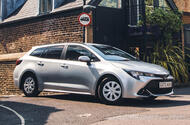 Did the last of the van-estates make a compelling case for their return?
Did the last of the van-estates make a compelling case for their return?
Why we ran it: To see if this hybrid can strike the sweet spot between a car and a van
Month 1 - Month 2 - Month 3 - Month 4 - Month 5 - Month 6 - Month 7 - Month 8 - Month 9 - Month 10 - Final report - Specs

Did the last of the van-estates make a compelling case for their return? - Final report
When the Corolla first joined us nearly 25,000 miles ago, I don't think anyone in the Autocar office expected much of it.
No disrespect to the legions of private hire drivers up and down the country, but the idea of driving one for the foreseeable future seemed Like the automotive equivalent of watching paint dry. However, this particular Corolla has a secret: it's actually a van in disguise.
This secret was a constant source of amusement for most. But any time someone asked about the Corolla Commercial - typically with a slightly incredulous "you came here in that?" while gesturing to my mock taxi - I'd simply fling open the rear door and show them the aircraft hangar behind the seats, which was usually met with an"ahhhhh" as they inspected it.
And I don't think they were just being polite: it is a genuinely unusual sight these days. The number of car-derived vans in production has plummeted, with now only a few remaining- and even then, most of them (the Suzuki Jimny, the Land Rover Defender and Discovery and the Ineos Grenadier) are lofty SUVs, leaving the Corolla Commercial as the sole survivor of the once popular van-estate class.
It's a shame that the market has gone that way, as although I was initially sceptical of the concept - the Corolla Commercial being not only more expensive but also having a significantly smaller load space and carrying capacity than an equivalent traditional Toyota Proace van - in practice, it makes a lot of sense.
This Toyota is clearly designed for the far-travelling tradesperson. Vans can be incredibly tiresome on long journeys, particularly if you have to navigate twisty country roads - not great when you're typically fighting a level of body roll that makes a monster truck look stable.
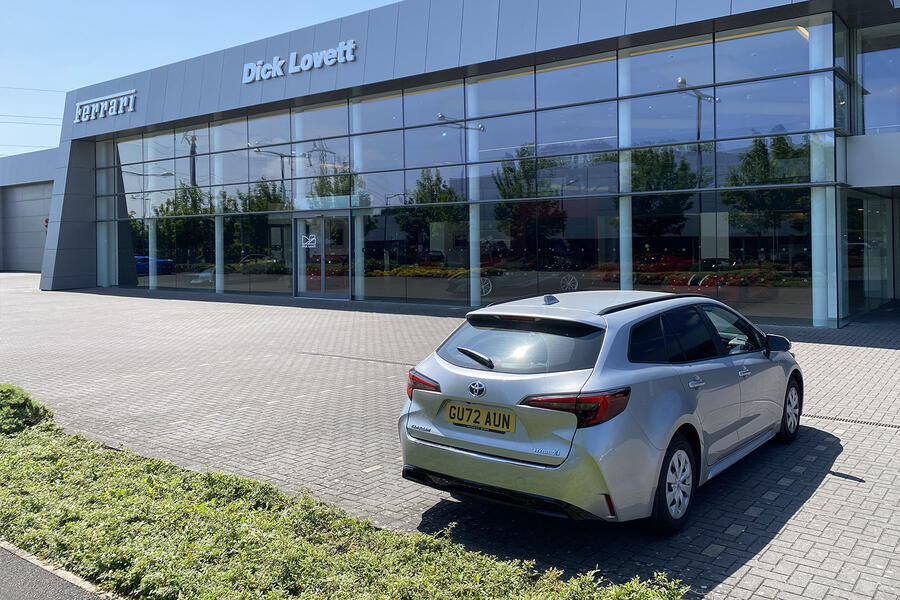
In the Corolla Commercial, it's kept to a fairly impressive minimum, and I'd even go as far as to say that it's more than capable of being genuinely fun and that the hilarious Gazoo Racing chassis sticker isn't actually for nothing.
The chassis feels stiff and strong, and the turn-in response is exceptional by the standards of many estate cars, let alone vans.
Amazingly, and perhaps most importantly when you're covering hundreds of miles a day, the Corolla Commercial is able to perform well on a B-road without sacrificing comfort.
The ride is the definition of pillowy, with a great primary ride that lets you float along the road, but the secondary ride is the most impressive of all, soaking up the harsh punishment that UK roads throw at cars with incredible ease. There are few other things on sale in any class that can rival it.
The e-CVT transmission isn't the greatest from a fun perspective, but it's not as noisy as you would expect, and it's sufficiently quick to respond when you put your foot down.
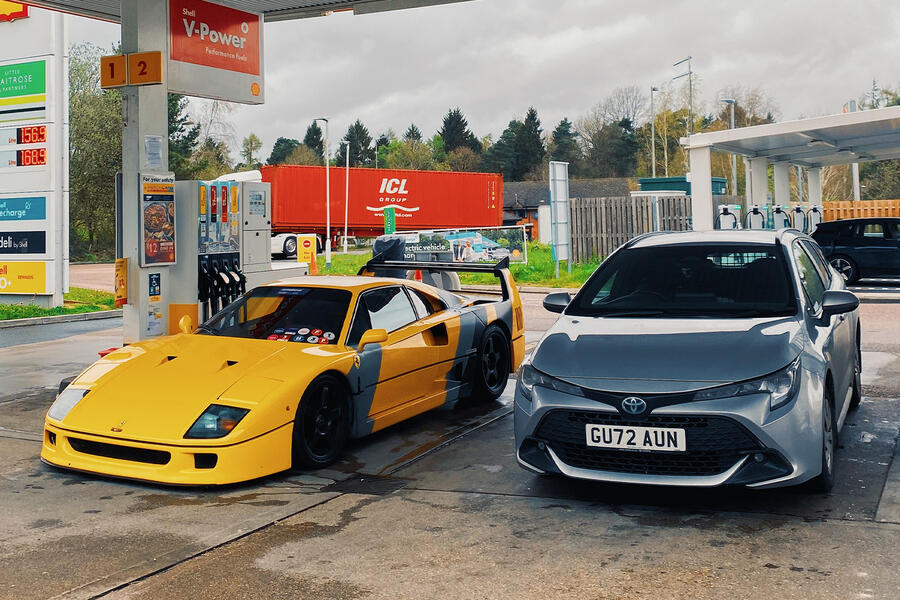
It also works well with the hybrid system to produce a pretty impressive average economy of 61mps - a great return for a 1.8-litre hybrid. Matt Saunders managed to squeeze a whopping 80mpg out of it over a 50-mile trip.
The cabin just makes sense too. Everything is where it ought to be, from the actual buttons (a bigger surprise than it should be) for the air conditioning in the centre console to the ability to disable lane-keeping assistance and switch between standard and active cruise on the steering wheel.
The low driving position was a welcome surprise and the (heated) seats were supremely comfortable, too. The only real downsides are a result of the van specification.
The cabin isn't exactly quiet at higher speeds - there's very little wind noise, but owing to the empty load bay there S no shortage of road roar, which really grates at higher speeds.
Speaking of which, the grate separating the passenger cabin and the cargo bay is set quite far forward - fine if you're shorter than six feet tall, but not so great if you're any taller as it limits the distance the seat can go back.
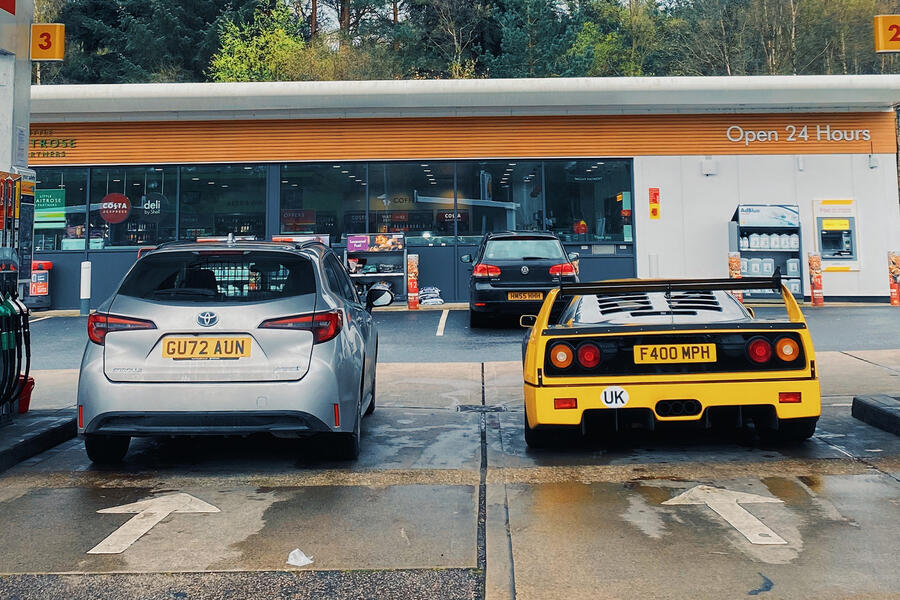
There's also a slightly worrying flaw - the blacked-out windows. Although they have to be blanked out by law in order to classify the Corolla as a commercial vehicle (and the fact that they are black rather than body-coloured makes them much less conspicuous and therefore less likely to be broken into than a traditional van), it doesn't stop being an absolute nuisance.
There's no offside three-quarter visibility at all, and a lack of blindspot indicators means that some manoeuvres - mainly coming out of 45deg junctions - were downright dangerous at times. That said, this isn't really any different from most traditional panel vans.
These were pretty much the only gripes I had with our Corolla, Apple CarPlay worked reliably (something of a rarity at this point), on four occasions the van moved a person's entire belongings with ease, and in all, it covered nearly 25,000 miles without going wrong. It truly was a trusty steed, and I'll miss it greatly.
Second Opinion
For me, it’s the automotive equivalent of my favourite fleece: far from stylish but obscenely good value and enduringly useful. My kind of stripped-out, no-nonsense two-seater. F
Felix Page
Love it:
Regen lever Shifting into regenerative braking through the traditional auto stick made driving surprisingly involving.
Big space Load bay was huge, to the extent that on one occasion I climbed into it for a decent service station nap.
Small screen Display was small but I think rightsized. CarPlay was well scaled and positioned for minimal distraction.
In the shadows It fitted in everywhere it went and, by looking more like a car than a van, I didn’t worry about break-ins
Loathe it:
Rattle and hmm... Side pocket dividers could come loose and rattle, and the base of the bay hop up and down on rough roads.
Final mileage: 25,803
Life with a Toyota Corolla Commercial: Month 10
Our time together is running out... - 29 June
I’m grateful to have nabbed the Corolla for a week before it’s cruelly snatched from our clutches after a year of hard graft. I was impressed by how tight and fresh it still feels after 25,000 miles and even more pleased to net nearly 70mpg over a busy week. A quick shout-out to the 15in hub-capped steelies, too: I’ve never driven with such abandon in our high-kerbed office car park.
Mileage: 24,796
Life with a Toyota Corolla Commercial: Month 9
Out of a Mulliner Bentley and back into the van – and we couldn’t be happier - 29 May
They say that absence makes the heart grow fonder, and in the case of our Toyota Corolla Commercial, that's definitely true.
Getting back behind the wheel after a few months away has made me really appreciate a car - sorry, van - that I initially thought was the most boring thing ever fitted with four wheels. None of the cars I drove in my time away were bad. In fact, some were downright excellent. But they all had their niggles, and I couldn't stop comparing them with our Corolla.
The only cars I drove during that period of time that rode better were the Ford Ranger Raptor (to be expected, thanks to its incredibly sophisticated off-road suspension set-up) and the Bentley Bentayga EWB Mulliner (which is advertised as the height of luxury and has a list price just under 10 times that of the Corolla).
What makes the Corolla so impressive is that you would never expect the ride to be anywhere near as pillowy as it is. In the primary sense, it's superb, just floating along, with minimal vibration making its way into the cabin.
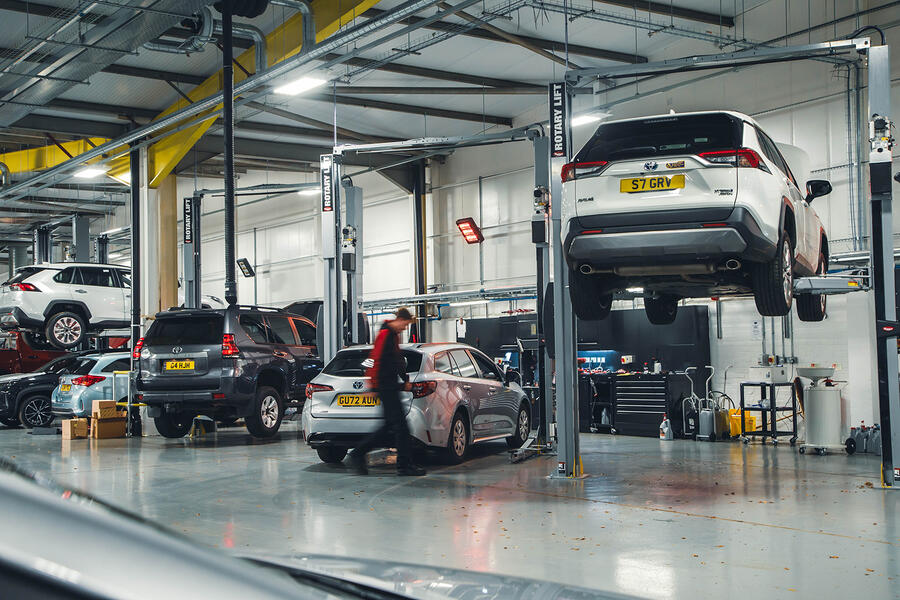
And in the secondary sense, it's on another level: bumps might as well not exist given the way this ploughs straight through them. It's at a level you would expect of a luxobarge, not a £25,000 (not including the tax in true commercial vehicle style) car-derived van.
I dread to think how many times 'effortless' has been used to describe the Corolla, but no other word fully sums up its behaviour. Now rapidly approaching the 25,000-mile mark, it has proved itself to be mechanically infallible too.
I was thinking about this as I drove it down to my local Toyota dealer for its second service. After I handed over the keys and took a seat in the swanky waiting area, I began to wonder if it was all too good to be true.
What if it transpired that everything was on the edge of its limits? It has been driven pretty hard and consistently averages just under 500 miles each week.
Surely that can't be good? I needn't have worried. Aside from the usual expected consumables (wiper blades, oil etc, nothing needed doing. A tough beast indeed.
Love it
In fine tradition
The air-con is controlled by a clear set of buttons reaching across the dash, with a classic segmented display that’s easy to read.
Loathe it
A roar deal
Road noise is seriously loud, due to that large, open rear. Nothing deadens the sound, so it just echoes around.
Mileage: 24,583
Life with a Toyota Corolla Commercial: Month 8
Toyota's cruise control is great - 24 April
I don’t know how people who are not motoring journalists feel about this, but I love conventional cruise control and in most circumstances dislike adaptive cruise control. I basically use it as a hand throttle, changing lanes and overtaking as necessary. Most cars with adaptive control don’t let you switch to standard mode, but the current generation of Toyotas do. Excellent.
Mileage: 19,356
Dishonest trip meter exposed, while B mode gets a fair hearing - 10 April
A few weeks ago I mentioned my intention to be a bit more scientific about calculating the Corolla's fuel consumption.
Annoyingly, the thing is just too darn fuel efficient, and I still only have a sample size of a handful of fill-ups. Still, it's enough data to conclude that, actually, it's a bit of a liar and tends to over-read by a couple of miles per gallon.
Hardly verdict-altering stuff: high 50s instead of low 60s is still pretty good, and I still think the car is generally excellent. I find the misreading computer quite odd; surely it's not beyond Toyota's engineers to make it accurate, and I can't imagine they're doing it to catch out lazy journalists.
Anyway, economy has recently improved further, but I'm not sure whether that's thanks to rising temperatures or because I got round to setting the tyre pressures. Probably a bit of both, given that the Corolla has a battery to condition and does a pretty good job of keeping the cabin warm even when the engine isn't running.
While we're on the subject of fuel economy, I thought it was worth a closer look at the Corolla's hybrid system, and I'll start with a clarification: a few weeks ago I mentioned the B mode on the gear selector as a loathe it', which prompted a letter from a reader.
First off, loathe is a hyperbolic way to describe my feelings, but years ago someone thought it was a catchy heading, and it's remained part of the template for these reports ever since. More accurate would be that I find it less useful than it could be, but that's not quite as punchy.
As a reminder, while the B mode in most EVs and hybrids ramps up the regenerative braking, in hybrid Toyotas, it works to keep the engine on when decelerating and the revs up for more engine braking.
As a result, if you were to drive in B mode all the time, you would get significantly worse economy. To be clear, that's not what I'm doing. My point is that I never have cause to use it, and it would be more useful if it acted like the B mode in most EVs.
The brake pedal in the Corolla is nicely progressive and the gauge cluster shows neatly the point where you're moving from regen to the friction brakes, but it would still be useful to quickly max out the regen with a B mode.
As it is, B mode does make the engine more responsive, so you might use it as a kind of sport mode, but I prefer to leave it in Eco because the effect is still superficial. That aside, Toyota hybrids seem to be the only cars whose Eco mode makes them nicer to drive.
Rather than render the powertrain apparently gutless, it seems to dull the initial part of the throttle pedal in order to keep you within the electric motor's capability.
Because electric motors have instant response, this feels adequate for a lot of town and suburban driving; once the engine fires up, the software seems to use as much electric power as possible to keep the engine revs down.
That's good for both fuel economy and dulling the CVT effect. In this latest generation of Toyota hybrids, the typical CVT 'mooing' has been significantly reduced anyway. You wouldn't want this system in a sporty car, but for the Corolla it's perfect.
It remains fairly quiet even when you floor it, and the lack of gearchanges means it's always smooth. As a stress-free and economical way of getting around, the Corolla still takes some beating.
Hot stuff
Even the lowliest Corollas come with heated seats – and a pair of massive rocker switches with which to operate them.
Display displeasure
I’m not asking for a bigger screen, but the small screen in the big bezel is ugly and doesn’t help forward visibility
Mileage: 19,111
It seems to run out of wiper fluid pretty fast... - 4 April
I was a bit miffed when I got back into the Corolla after some colleagues had been in it, as I pulled the wiper stalk and the washers pathetically spit some fluid before dying entirely. Either someone has been drinking it or the van lacks a warning for low washer fluid. Hardly a deal-breaker but suboptimal nonetheless.
Mileage: 18,997
Life with a Toyota Corolla Commercial: Month 7
Everyone in the office seems to like you when you’ve got a van - 13 March
The rule when you run a van as a long-termer on a car magazine is that, before you know it, people will come out of the woodwork asking to borrow it because they need to move house.
Indeed, I'd been the custodian of the Corolla for less than a month when in came an email from Damon Cogman, art editor on our sibling title Classic & Sports Car.
Because I'm keen to give the Corolla the chance to fulfil its destiny as a van, I duly handed over the keys. I thought he might complain about how small it was, but it turns out the Corolla was ideally suited to the task. Damon said the cargo area easily swallowed a chest of drawers, as well as countless odds and ends.
It had a few other surprising trump cards. Vans tend to have very firmly sprung rear axles to cope with lots of payload, but the Corolla Commercial just retains the estate's suspension. It might limit how much weight you can ultimately carry, but the compliant suspension also means that any precious cargo isn't jostled or shaken about. The hybrid system's smooth power take-up does the same when accelerating and braking.
This also seems like a good time to talk about what actually constitutes a van. As far as I'm concerned, this Corolla is just a standard estate with ride-improving 15in wheels. The one thing that regularly reminds me it's not, however, is the blindspots.
As part of the Corolla estate's transformation into a van, the rear electric windows are disabled and a blackout film is applied to all of the rear side windows (but not the rear windscreen).
That creates quite a blindspot, and without the benefit of either electronic blindspot monitoring (available on the top trim of the normal Corolla but not on the Commercial) or the huge side mirrors you get in a more typical van, it's one you're very aware of.
It's especially the case when I'm leaving my usual parking space, as it involves backing out of a hedge-lined lane and trusting that the traffic on the main road is attentive enough not to T-bone me. So my first thought was: why don't I just peel the blackout film off the windows? With a bit of help from a hairdryer, it can't be hard, surely?
The reason why not is the law. Well, it's the murky waters of tax and guidance thereon, mainly. The Corolla Commercial is termed as a 'car-derived van' or CDV. They're defined as vans that are based on the same design as a car and can't weigh more than two tonnes fully loaded (so don't expect to see many electric CDVs).
They can't have any rear seats, rear seatbelts or mountings, and if rear side windows are present, they must be made opaque and fixed. In other words, peeling off those stickers would get you in hot water with the tax man, given they are a condition of the Corolla Commercial's low, £700 yearly company van tax rate. I have been wondering why someone would pick a Corolla Commercial over a more conventional van, and while it's a niche pink, I'm starting to see it.
If you don't have a huge amount to carry, the additional refinement, driving dynamics when empty and fuel economy might well swing it. The Corolla's CDV status gets it another benefit over normal vans: you don't have to stay under 60mph on dual carriageways.
Love it
Big gearlever
Sure, it could be replaced by a toggle and a cubby, but I like the mechanical interaction. And unlike a toggle, it never disobeys you.
Loathe it
B-moan
I wish the B-mode on the gear selector just ramped up the regen. Instead, it also fires up the engine for maximum engine braking.
Mileage: 18,666
Accurate economy is another bonus - 20 February
Since I took over the Corolla van, I’ve been trying to do brim-to-brim measurements for its consumption. This is actually quite tricky, because after the fuel nozzle first clicks off, it will take another three litres or so. On a total capacity of 43 litres, that means quite a big margin of error. A couple more fill-ups are needed, but it does seem to be pretty true to the readout, at around 57mpg
Mileage: 18,319
The spec of our Commercial could have been tailor-made for its new custodian - 7 February
I was supposed to run the Mazda MX-30 you may have seen in last week's issue, but over Christmas I swapped cars with Jack Harrison, the Corolla's previous custodian, and I rather fell for the wheel-trimmed wonder.
He needed four seats. I didn't. So a deal was struck. What particularly charmed me was the spec, which is as basic as a modern Corolla gets and such a nice breather from all the superfluous tinsel that most modern cars have.
Let's run through some of its spec. Alloy wheels? Nope. Steel wheels and wheel trims. They used to be the norm but are now a bit of a novelty.
And they deserve a comeback, not least because they're virtually impossible to kerb - and if you do, a fresh set of four will cost a few tenners. The 65-aspect ratio of the 15in tyres also improves the ride, which can be slightly crashy on Corollas with 18in wheels.
Leather seats? No thanks. Leatherette seats? Please spare me. The cloth seats in the Corolla are warm in winter and breathable in summer. I don't get the luxury appeal of leather and I'm glad to be rid of it. They are heated, though.
That's controlled by a pair of huge rocker switches that you can easily stab without looking, or while wearing gloves. Best of all: no need to wait for a screen to boot up before you can turn them on.
Talking of manual control: wipers. I've not found any rain-sensing wipers that get it completely right, so I always end up fiddling with the stalk. I might as well control the intermittent setting myself, and the Corolla lets me.
The Corolla also lacks auto-dipping mirrors. You lose a lot of detail with the mirrors dipped, so I like to have control over it. One more: it has a manual tailgate.
Some big, heavy SUVs have big, heavy tailgates, so I do see the point of an electric tailgate in those, but in a compact estate car they just make opening the boot a lot slower.
It's a far cry from the poverty spec' cars you used to be able to buy, though. The seats are really comfortable, there's cruise control, Apple CarPlay lets me stream music and it has a super-smooth automatic gearbox.
It's just modern where it needs to be, without trying to reinvent the wheel. That said, the campaign for the rehabilitation of the wheel trim starts here.
Love it
Steering wheel
It is round and has a thin rim. Not fashionable, perhaps, but better for actually feeling what the car is doing.
Loathe it
Maximum driver height
At 6ft 2in, my driving position is one click away from the seat rubbing against the bulkhead.
Mileage: 17,800
Life with a Toyota Corolla Commercial: Month 6
Our van rattles more than the standard Corolla - 24 January
I’ve been very spoiled by rattle-free new cars, so whenever I get into one that does make an annoying noise, it gets amplified in my head to an air-raid siren. The Corolla van’s load bay floor is just a large board of plywood that rests on some plastic pegs. Simple problems have simple solutions: some felt furniture pads later, peace was restored.
Mileage: 17,456
It's frugal but it has a small tank... - 17 January
BONG! That’s the sound of the Corolla’s low fuel alert, something you’ll hear depressingly often. Sure, its tank is on the smaller side – it’s only 43 litres – but it seems to need a confidence kick. Time and again I’ve pulled in to fill up with 10 miles of indicated range left, only for there to be 10 litres left in the tank. Odd.
Mileage: 17,045
Toyota's famed reliability doesn't extent to the infotainment - 10 January
The Corolla van’s Apple CarPlay has suddenly started playing up – annoying, because it’s all I tend to use for audio and sat-nav. Sometimes it will connect first time just fine but other times it requires repeated attempts to pair the two, culminating in a lot of mashing the ‘connect’ button. More than once I’ve had to restart the whole system to make it work.
Mileage: 16,358
Life with a Toyota Corolla Commercial: Month 5
Turns out there’s no comfier, more relaxing mile-muncher than a van - 1 November
I think it's fair to say that I rack up the most long-termer miles at Autocar.
This Corolla first graced the pages of this magazine only in June, yet I've already put a frankly ridiculous 11,000 miles on the clock.
It's rare for me to be taking any photos within two hours of home, and getting anywhere requires a trip down all sorts of A- and B-roads, with an obscene amount of motorway driving too. But you know what? I don't think there's anything on the fleet that I would rather do it in.
This van takes the best bits of a number of cars on our fleet. For example, the floaty ride is truly outstanding.
Sure, a lot of that is probably to do with the tiny wheels (the rims themselves are only 15in, with tyre sidewall taking up 65% of the whole wheel), which alone would soak up the lumps and bumps of Britain's poorly paved road network astoundingly well; but when paired with softly sprung suspension, it's an almost unbeatable package.
You would have to search far and wide to find something else that's this smooth for similar money in my view. Isolation is another thing worth mentioning. The ride is obviously a part of it, but its quiet enough to hear a penny drop when you're inside; wind noise is barely audible and tyre roar is muted. Stick some Fleetwood Mac on - easily done, thanks to the fast infotainment system, and worth doing, due to the unexpectedly decent sound system - and I've got myself one hell of a long-distance cruiser.
With the active cruise control in full swing and my arm on the perfectly designed central armrest, I can swan up and down motorways all day.
If anything, the Corolla's biggest drawback for me is what will be its biggest strength to most people: its cavernous boot. I could use something with four seats myself, but if you were a self-employed plumber or something like that, I can see why you would love it.
You (and more importantly your partner) would surely be happier in here than in a 'proper' van. It's also absolutely no surprise, given this is a Toyota, that nothing has gone wrong with it. It really is our fleet's golden star.
Love it
Mr Inconspicuous
Sleek enough for the city yet sober enough for everywhere else, it lets me glide about in total anonymity.
Loathe it
The screen can be blindingly bright at night, but I can adjust it only by going into the settings menu. Can’t I just have little dial?
Mileage: 11,130
Life with a Toyota Corolla Commercial: Month 4
Who needs a Range Rover? - 25 October
Richard Lane’s long-term Range Rover can eat its heart out: as far as I’m concerned, the Corolla has one of the best armrests in the business. Wide enough for driver and passenger to share without awkward elbow rubbing, it’s at just the right height to be incredibly comfortable and is far enough forward that you can really cruise with it.
Mileage: 10,200
Corolla's sound system is top drawer - 11 October
For a van, the Corolla has a weirdly wonderful sound system. It retains the speakers in the rear doors from the regular estate, allowing sound to bounce around the cavernous rear load bay. It’s like a mini opera house back there. The acoustics are better than some other cars I’ve tried with complex and expensive systems made up of 10 speakers or more.
Mileage: 8940
Life with a Toyota Corolla Commercial: Month 3
The Corolla's systems aren't exactly relaxing - 20 September
Our Corolla Commercial van really wants me to know what awaits down the road, which it does by treating me as if I’m in an airport. When I hear a friendly but firm voice call out ‘attention’ through the speakers, I have about five seconds to guess whether she will be warning me about slow traffic, queuing traffic or standstill traffic ahead.
Mileage: 8256
Life with a Toyota Corolla Commercial: Month 2
Of course, practicality is the Commercial's strong point - 16 August
There are endless cubbyholes in the cabin to stop things rattling about or being left on display, with ample space for your phone, wallet and keys in the centre slot alone. The heated seat switches, just ahead of the gear selector on the centre console, are ideally sited to sneakily turn on your passenger’s one if you are feeling a bit mischievous, too.
Mileage: 5839
Our electrified Corolla is a noisy machine - 2 August
My hybrid van’s electric motors make some very strange noises. They clunk and groan like nothing else I’ve ever been in, even ticking like a well-hidden time bomb every now and then. While I’m on this topic, the noise that emanates from the car at low speeds is actually louder than that from the four-cylinder petrol engine, due to pedestrian safety regulations.
Mileage: 5100
Life with a Toyota Corolla Commercial: Month 1
Lights that alert you to potential danger can sometimes be literally a lifesaver - 26 July
One of my main gripes with modern cars – shared with my colleagues, my family and very nearly everyone I’ve ever talked to about them – is the overzealous warning system that can be an absolute pain in the proverbial to turn off.
In the Corolla, though, the vast majority of these systems just make sense. Included in the £29,440 base price is lane keeping assistance, active cruise control, emergency steering assistance and collision avoidance, all working thanks to a small radar system hidden away behind the front grille. The best part about it? Unlike a few other systems I’ve tried, they actually work and aren’t too overbearing.
The active cruise control is simply sublime. Although it’s initially complicated to activate (you need to hit the buttons in the right order, or you’ll simply be given a pretty unhelpful message telling you to go and check the owner’s manual and come back once you know what you’re doing), it’s one of the best things you could ask for in slow-moving traffic. When active, it takes control of the accelerator and brakes and seriously firms up the steering, gently suggesting to you that you really ought to leave it alone as it knows what it’s doing.
I thought I’d hate not being in total control of it, but it’s so good that I learned to trust it quite quickly. Feel like you’re a bit close to the car in front? Just adjust the distance, easily done from a button on the steering wheel. Want to set it up to go to a higher speed? Again, easily controlled from the wheel. Its only shortcoming is that it’s quite nervous when it comes to overtaking on the motorway. If you’re approaching a car, it will start braking before you reach it unless you pull out incredibly early. Because of this, as nice as adaptive cruise is, I tend to reach for the more traditional speed-set cruise control on fast-moving roads.
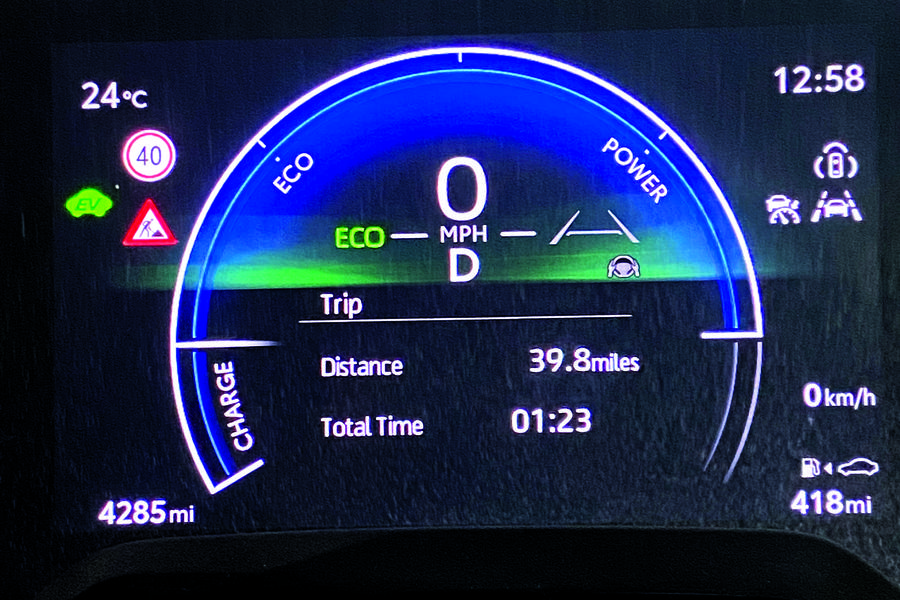
The radar also has other uses. It scans the road ahead for obstacles – pedestrians, parked cars, that sort of thing – and reacts accordingly. While it can be annoying at times (it really likes to go absolutely ballistic when you’re coming up to a parked car on a narrow street, thinking that you’re about to smash right into them), at others it’s a non-hyperbolic lifesaver.
I was driving on an unlit dual carriageway on a pitch-black night, not wanting to use high beams due to the volume of traffic on the other side of the road. Suddenly, the car decided to flash the headlights twice in very quick succession, revealing a cyclist in all black with no lights cruising along the white line. The flash, caused when the radar picked up the hazard about 75m away, allowed me to take evasive action, leaving the all-but-invisible menace unharmed. I dread to think how it might have turned out if I’d been going by the candlelight-rivalling bulbs of my Fiat Coupé…
I’ve also found the auto-hold feature pretty useful. This activates at first when you press a button in the centre console, then in every case when you press the brake pedal all the way down while at a standstill. What’s not useful is how you’ve got to remember to turn it back on whenever you start the car. That gets incredibly annoying incredibly quickly.
What makes it even worse is that every other assist remains set to whatever you chose last time, but this one doesn’t. I’m hardly the most forgetful person, but it keeps catching me out – fine on an empty street, slightly alarming when you start rolling forward while waiting for a gap at a busy roundabout.
Love it
Infotainment set-up
The interior screen is pretty much the perfect size – large enough to see clearly without being overbearing – as well as fast and easy to navigate
Loathe it
Put your foot down!
Our Corolla Commercial’s CVT gearbox has very poor throttle response even with hybrid assistance, making it harder to go for gaps in traffic than it should be.
Mileage: 4867
The Corolla van is spacious, but not all-encasing - 12 July
I was slightly shocked to discover that, due to a high boot floor and narrow wheel arches, my dad’s drum kit and speakers wouldn’t quite fit in the back of the Corolla van, considering that it comfortably fits in his Skoda Octavia Estate. It has redeemed itself by swallowing the contents of a friend’s university flat and their bicycle, though.
Mileage: 4580
Welcoming the Corolla to the fleet - 28 June 2023
Us photographers are an annoying breed: we insist on journalists driving cars out to the middle of nowhere, will always ask for one more pass and will always have a frankly ridiculous amount of kit to hand, just in case.
You would think a van would be our perfect method of transport, then, right? Well, as much kit as we have, they are if anything probably a little too big for us. Plus, thieves have a habit of viewing vans as oversized lucky-dip boxes.
So what do you do if you need a reasonable but not ridiculously large amount of cargo space in an inconspicuous package? You go for a car-based van, such as my new Toyota Corolla Commercial.
From a distance, it looks like a standard Corolla Touring Sports estate. It’s only when you get close that you notice the rear windows are blocked off with a black film (designed to make its van identity as hard to realise as possible) and you realise all is not as it initially seems.
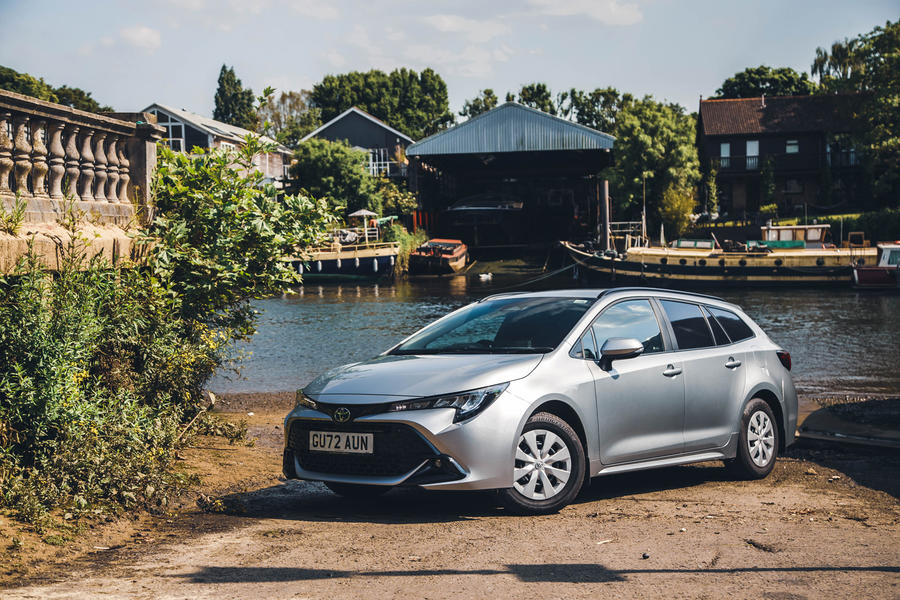
It has the same ‘self-charging’ hybrid system as its rear-seated cousin, with a 1.8-litre four-pot petrol engine, an electric motor and a small battery. That means there’s a total of 138bhp on tap, delivered to the front wheels through an e-CVT.
There’s a fair amount of goodies included for the £24,533 (excluding VAT) base price too, including a rear-view camera, heated seats and an infotainment touchscreen with Apple CarPlay and Android Auto.
Although they are mechanically identical and almost visually so too, the differences between the Corolla car and Corolla van are immediately obvious once you open the latter’s rear doors and find that the back seats are missing (something required by law in order for anything to qualify for commercial vehicle tax benefits).
They have been replaced by a cavernous 1326-litre cargo bay and a full-metal bulkhead grille for separation between the driver and the load being transported. I’m so used to seeing seats inside a car like this that it looks simply massive, but it’s not quite as spacious as even the smallest ‘proper’ vans.
For example, the smallest Toyota Proace City variant has a load bay of 3300 litres, despite being 247mm shorter overall. Still, I’m able to transport objects up to 1860mm long and 1430mm wide.
It’s also worth noting that there’s a normal rear screen. That’s great for driving because the blacked-out side windows create blind spots large enough to lose a medium-size container ship in, but it means that whatever I leave in the back is on full display to the world.
The payload is 435kg, which sounds like a lot until you compare it with the aforementioned Proace City’s 650kg load-lugging capability. Heck, even the standard Corolla estate can carry 100kg more than our new long-termer in certain specifications.
This decreased carrying capacity is offset by the driving characteristics, though. As you would expect, this ‘van’ just feels like a car. The control weights are light around town but the steering is firm and stable at high speeds, while I’ve also been impressed by the quietness, comfort and fuel economy – all things that you want in a vehicle prone to being driven for exceedingly long periods.
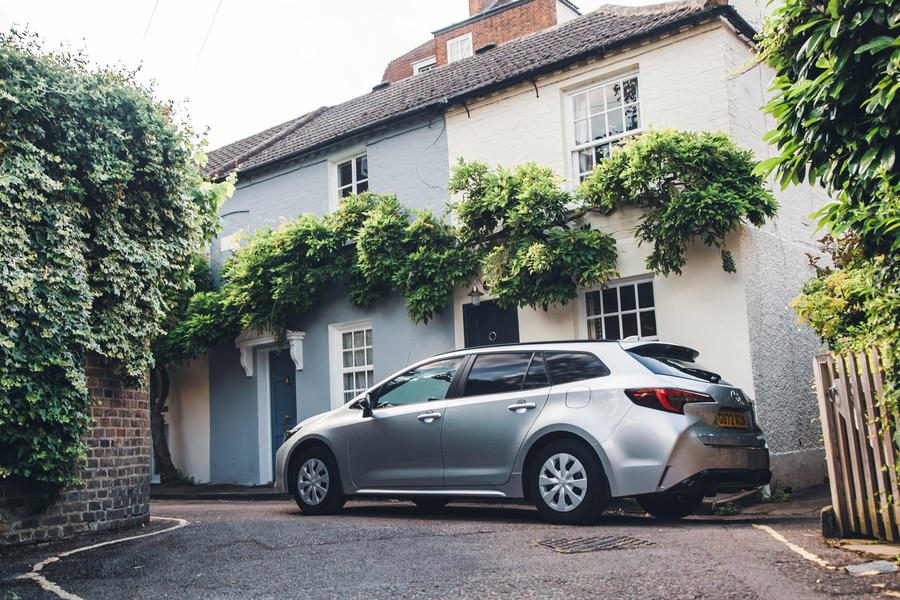
Although it glides smoothly over the appalling roads around my local town of Poole, the rear feels much more softly sprung than the front, giving the car a tendency to rock back and forth for a bit after hitting large bumps. It’s not unpleasant, but it does take a little bit of getting used to.
The radar-guided adaptive cruise control is a real stress-reducer in traffic, as the car does all the work for me, with the incredibly heavy steering and accurate lane keeping assistance seeming like they would be happiest with no human intervention in the slightest.
If that’s not your cup of tea, these two systems can be turned off via the controls on the steering wheel, while other safety equipment such as automatic collision avoidance can be disabled in the menus. Best of all, it remembers your preferences for next time – which isn’t always the case on other cars.
The powertrain is keen to stay in electric mode around town, only really using the combustion engine under acceleration and above speeds of around 30mph, and the power delivery feels incredibly smooth.
The claimed WLTP figure of 64mpg seems somewhat optimistic, but even with my feet of lead, I’ve managed to average 60mpg overall so far, and a recent hour-long motorway run with fairly heavy traffic yielded an incredibly impressive 72.6mpg figure.
So, it’s big, it’s comfy and it’s economical. On first impressions, I’m going to have to try quite hard to find things to moan about during my time with this Toyota, and I doubt that “my dog doesn’t like it” would be a valid criticism.
Second Opinion
Jack’s Corolla is up there with the best vans, mainly because it doesn’t look like one. It does all those vital tasks so easily that it should be a winner for his job. One area where it may come unstuck is passenger room. He and I aren’t blessed in the leg department, yet even for us the seat is just a few inches off the bulkhead.
Piers Ward
Toyota Corolla 1.8 VVT- i Commercial specification
Specs: Price New £29,440 Price as tested £29,956 Options Silver metallic paint, £525
Test Data: Engine 138bhp at 5200rpm Torque 104lb ft at 3600rpm Kerb weight 1410kg Top speed 112mph 0-62mph 11.1sec Fuel economy (claimed) 61mpg CO2 105g/km Faults None Expenses None
2024 Dacia Sandero Stepway Long-Term Test by Giga Gears
 Value-led supermini arrives with a challenge of winning over the ex-keeper of a Clio
Value-led supermini arrives with a challenge of winning over the ex-keeper of a Clio
Why we’re running it: To see how similar Britain’s cheapest supermini is to its class-leading sibling
Month 1 - Specs

Life with a Dacia Sandero Stepway: Month 1
Welcoming the Sandero to the fleet - 17 July 2024
Reader, I'm disappointed. Not wanting to be left behind by the industry, I had a man come to quote for installing an EV charger at my home. "Nope, can't do it" was his instant verdict.
Because my flat is 35 metres from the block's car park, they would need to dig up the drive and lay an armoured steel cable, which would cost many thousands of pounds and then wouldn't work properly anyway, due to voltage drop.
Therefore I'm relieved and very grateful - as should be the other 100-plus residents here, and indeed those in the other blocks on my road, and in fact millions of Brits - that combustion-engined cars are still being made and, given that this isn't an affluent area, that some remain 'affordable.
Dacia is dedicated more than any other manufacturer to keeping the working class mobile, as evidenced by the fact that you can buy a factory-fresh Sandero for just £13,795.
And that's not for some horrifying crapbox but a truly modern compact hatchback that can accommodate five people in comfort and is composed of parts that Renault is happy to put its name to.
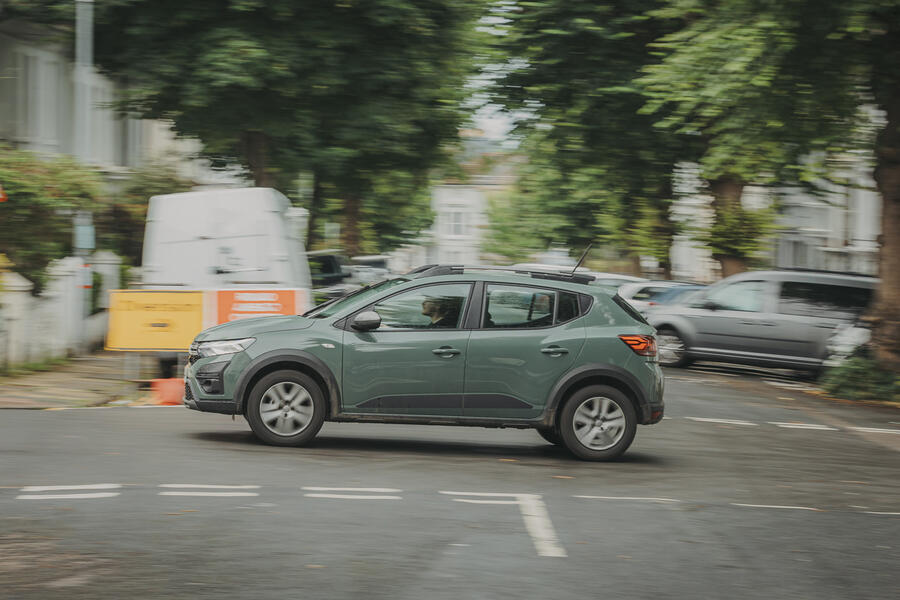
This is also a company that couldn't give a damn what Euro NCAP says about its refusal to fit driver assistance technology that's expensive yet in many cases unwanted, unnecessary and sub-standard. Stuff your multimillion-pound, limited-edition supercar makers: the Romanians are who I admire.
My own Sandero actually costs £16,295 because it's an off-roader-lookie-like Stepway in Expression trim, but that's still less than half the price of the average new car in the UK - and if you forgo the extra ride height, plastic body trim and root rails, you can get this spec (which you will want, because it adds an 8.0in touchscreen, rear parking sensors and a reversing camera to the standard air-con and Bluetooth-equipped four-speaker stereo) for an incredible £14,795.
In any case, most people get their cars on finance, and the Expression is actually E7 per month cheaper (at just £140) than the Comfort, due to its better resale value. Add another £6 per month if you must have the Stepway, despite its conspicuous lack of four-wheel drive.
The one big problem with this premise is that Renault is currently offering a 0% APR finance deal on its entry-level Clio, which uses exactly the same 1.0-litre three-cylinder turbocharged petrol engine (which makes 89bhp and 118lb ft of torque) and six-speed manual gearbox, and has a comparable level of standard equipment, for just £142 per month. I previously ran a Clio, albeit in pricier E-Tech hybrid form, which I absolutely loved and which Autocar now considers the class leader. So will I find justification in recommending the Sandero to you instead?

The interior probably won't pull any fence-sitters down, if I'm being brutally honest. There's nothing wrong with it fundamentally. Analogue speedometer and tachometer dials now seem a rare treat, the infotainment software features Apple CarPlay, the seats are adjustable and give the driver and passenger enough space, and I have no objections to dark cloth upholstery. But away from the steering wheel, the plastics are far from tactile delights, and the touchscreen has a matt finish that feels weird to touch.
I suppose the design may sway some, particularly after a light refresh in 2022 that implemented Dacia's new brand image, which to me gives it a slightly more upmarket appearance (although I did wonder why they had swapped a D-shaped logo for an X-shaped one until someone pointed out that it's meant to be a D and a C...).
I can also see some people being drawn to its 4X4 look, especially in the metallic Dusty Khaki seen here. In fact, I've already had someone stop to ask how it drives because they loved the look. No, I'm not making that up, and I never had that happen in my many months with the Clio. My answer to him was "It's great, given the price" '.
It doesn't feel like a Clio, though. In fact, it feels remarkably different, given that they are so closely related, having a much softer suspension set-up and thicker-walled tyres, which gives the ride a totally different character, and there's much less appetite for dynamic cornering evident in its handling.
It's still early days, so I haven't yet worked out exactly how I feel about my new long-termer. I already have a few long motorway trips booked in, so we will soon see. Although my lack of any reservations about that prospect probably says something in itself.
Second Opinion
I’ve approached the Sandero with fresh eyes now as the owner of the cheapest Renault, an £18k petrol manual Clio. This Dacia is notably more rudimentary and basic-feeling, despite near parity on price to its sibling. Dacia has clearly taught its parent company a few tricks about how to build affordable cars.
Mark Tisshaw
Dacia Sandero Stepway TCE 90 Expression specification
Specs: Price New £16,295 Price as tested £16,945 Options Dusty Khaki metallic paint £650
Test Data: Engine 1.0-litre turbocharged petrol Power 91bhp Torque 118lb ft Kerb weight 1072kg Top speed 109mph 0-62mph 12.2sec Fuel economy 50.4mpg CO2 119g/km Faults None Expenses None
2024 Abarth 500e Long-Term Review | Giga Gears
 Can this pint-size but pricey hot EV deliver day-to-day practicality and B-road thrills?
Can this pint-size but pricey hot EV deliver day-to-day practicality and B-road thrills?
Why we’re running it: This hi-vis EV could be the future of hot hatches. Should we be excited?
Month 1 - Specs
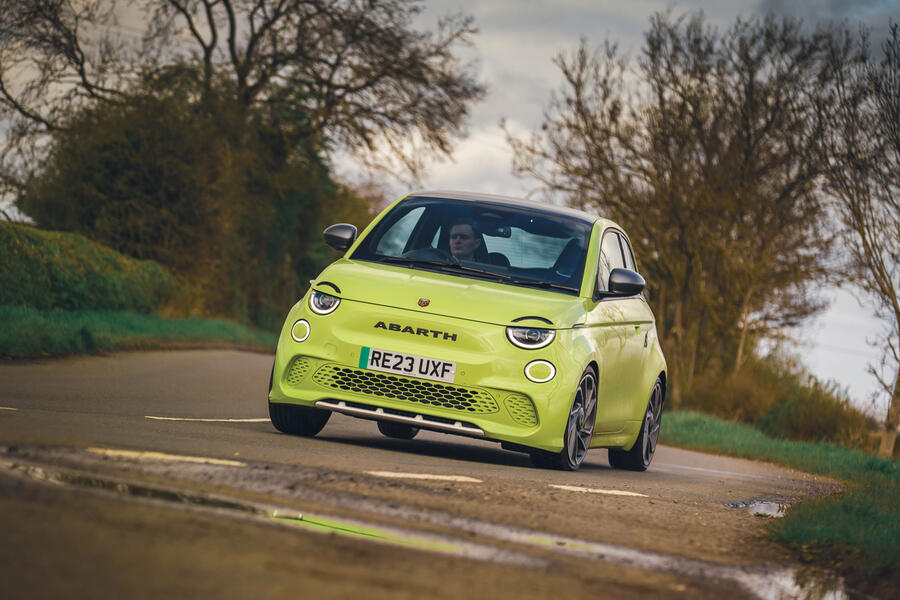
Life with an Abarth 500e: Month 1
Welcoming the Abarth to the fleet
Cliché though it is to report on the experience of moving house with a long-term test car, I can't really neglect to highlight the irony of this diminutive supermini replacing the comparatively quite humongous Volkswagen ID Buzz outside my place of residence, just a couple of weeks before I'm due to vacate the premises.
Come moving day, had I still had the VW on hand, I would have removed the Buzz's false boot floor, opened the massive tailgate and twin sliding doors, folded the rear seats flat and had enough space for around half of the contents of the flat (or at least most of my partner's wardrobe).
No van rental, no tears over smashed plant pots and crumpled paintings and no need for more than two or three shuttle runs between new pad and old.
Things might not be so simple with the two-door, tiny-booted Abarth 500e. A spot of quick maths reveals it to be one of the smallest full-sized electric cars you can currently buy in the UK. I might ask if the flat's next occupants fancy keeping our dining table.

Let's look on the bright side, though (and I'm not talking about the Acid Green paintwork). The Abarth's compact proportions have already proven to be much better suited to city life: it fits into my tiny parking space with ample room either side, it can nip into tight gaps in traffic so I rarely miss a green light and it makes light work of the high-kerbed helter skelter coming out of Heathrow's Terminal 5 short-stay car park.
Keen urban drivers have long had to confront a tricky dilemma when buying a car: do you want something that moves with relaxing frugality through cramped, congested city streets, or something brawnier, firmer and less practical but which comes into its own once you've vaulted the ring road and found some twistier and more enticing asphalt?
Rarely are you able to have it both ways. Until now, perhaps. Lay off the loud pedal (literally, in this case) and the hot 500e is a fairly sensible commuter, down to the surprisingly generously damped suspension and Savoy hotel-friendly turning circle. But having driven it on the North York Moors a few months back, I know its a giggle on a good road, too.
The tricky bit, though, will be reaching those good roads in the first place, because just getting clear of the M25 takes about 15% of the compact, 42kWh battery. So by the time I've nursed it to the start of one of my favourite test routes in, say, Oxfordshire or Sussex, it's time to plug in - and the Abarth doesn't top up its battery fast enough to make that a trivial concern. I feel a shift in mindset coming on.

Trivialities such as range and practicality aside, you might have already made up your mind about the 500e, and especially so if you've heard the artificial sound generator under the boot, from where it emits a synthesised version of the petrol-powered Abarth 595's exhaust note in a bid to heighten the sensory satisfaction.
I'll deal with it now and try not to mention it again: some think it's fun if only for a minute or two, while others have branded it grating, unnecessary or just pure naff. I'm largely indifferent; I don't think the 595 has an especially enticing soundtrack anyway, so it's no real heartache to go without in its electric replacement.
Anyway, once your neighbours know you can make your car either very loud or very quiet at the press of a button, it becomes rather embarrassing to be heard willingly rumbling and 'revving' your way out of the cul de sac, and the unremitting drone that accompanies a 70mph cruise is nigh-on unbearable. The upshot is that I turned it off within seconds of taking delivery, and it won't see much action on my watch.

But I'm already questioning if Abarth needed to stoop to such superficialities in its pursuit of character and whimsy. Look at this thing: it may be tiny, but it's about as shy and retiring as Kanye West.
There's no danger of losing it in a supermarket car park among a sea of greys, and I've already twisted more necks driving it down the high street than I have with any mega-powered sports car.
Let's not forget this is the performance version of what is already a fun little car. One question I seek to answer over the coming months will be whether the Abarth's er hanced agility and more generousseserves merit the lofty premium it commands over the Fiat-badged donor car, in which I've previously covered some very enjoyable miles.
Oh, and about that premium. The car you're looking at - with its relatively spartan interior, 185-litre boot, 130-mile real-world range, 85kW maximum charging speed and largely decorative back seats - costs £38,795. Don't write in - that's not a misprint. Jaw off the floor yet? Good.
Let's crack on and see if it comes anywhere close to justifying price parity with a speccy Ford Focus ST, and whether the fun factor can outweigh the inevitable frustrations wrought by its limitations.
Second Opinion
I quite like the Abarth 500e – I can see it blending into life easily as a runabout that still brightens up B-roads. As an electric hot hatch, though, it lacks a bit of exuberance – and no, the sound generator doesn’t count. I’d be curious about a comparison with the base Fiat to see how much the scorpion badge is really worth.
Illya Verpraet
Abarth 500e Turismo specification
Specs: Price New £38,195 Price as tested £38,795 Options Acid Green paint £600
Test Data: Engine 1x permanent magnet synchronous motor Power 152bhp Torque 173lb ft Kerb weight 1410kg Top speed 96mph 0-62mph 7.0sec Fuel economy 3.4mpkWh CO2 0g/km Faults None Expenses None
2024 BMW M2 Long-Term Test with Giga Gears
 Small, rear-driven coupé with a furious turbo six arrives on our fleet to much fanfare
Small, rear-driven coupé with a furious turbo six arrives on our fleet to much fanfare
Why we’re running it: To celebrate the survival – and indeed evolution – of the proper sports coupé
Month 1 - Specs

Life with a BMW M2: Month 1
Welcoming the BMW M2 to the fleet
Is it possible for a car to be at once gloriously minimalist and excessive and overgrown? Because somehow the BMW M2 that I will be running for the next few months feels like both.
In an age when the BMW range has expanded to 17 models and is headlined by brash Teutonic titans such as the iX and XM, there's real throwback charm to the simplicity of a small two-door coupé. And yet this second-generation M2 isn't as small or simple as its predecessor.
It has grown notably in size and stance, such that it now feels more like a mini M3 than a descendant of the 1M Coupé - which in a way it is.
A quick recap: the previous 2 Series Coupé shared a rear-wheel-drive platform with the 1 Series hatchback. But when the latter switched to front-wheel drive for commercial reasons, the only way the 2 Series Coupé could survive with a driven back axle was to switch to a specially shortened version of the CLAR platform used by the 3 Series saloon.
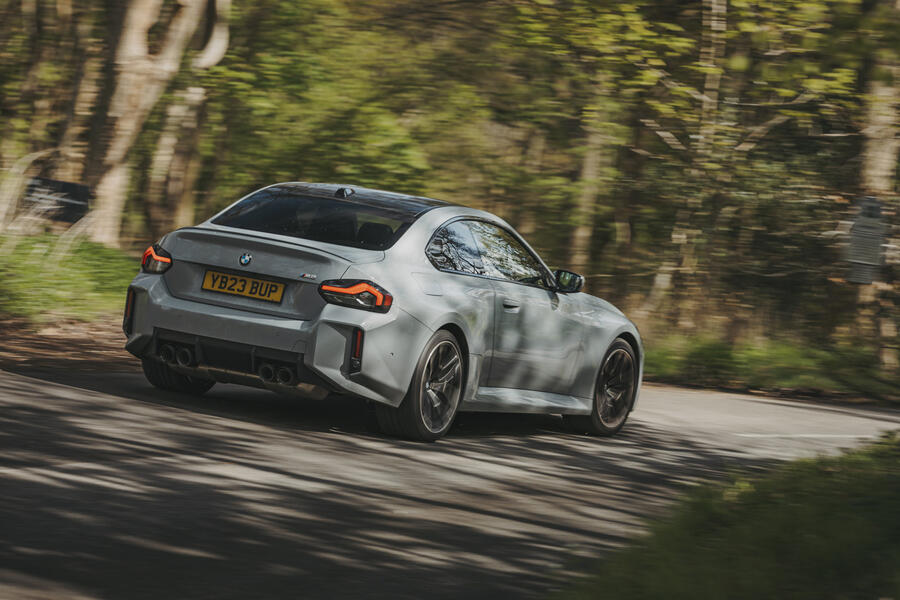
Power still comes from a blown straight six, but it's a newer, twin-turbocharged unit tuned for 453bhp - a hefty chunk more than the 405bhp in the previous M2. The result is a model that's bigger and beefier in almost every aspect.
However, the fact that the 2 Series Coupé - and by extension the M2 - survived at all is a testament to BMW's continued passion for driver's cars. There's a reason why both the standard and M ranges are full of big SUVs, after all.
And, as regular Autocar readers will know, those engineers have nailed it: the M2 scored four and a half stars in our road test and has topped a group test of old-school, real-driven, manual-shift sports cars.
It's good, then. So my mission here is to find out what it's like to live with over an extended period. After all, this is the sort of machine that really can serve as both a weekend sports car and a daily driver, especially now that it has grown a bit. The rear seats are actually just about usable and there's plenty of room in the boot.

The base price of the M2 is now £62,420, which isn't exactly cheap. But then you would pay nearly double that for an XM, and if you did, you would have to deal with me questioning your life choices.
And while M cars don't feature separate trim levels, you can get a bit lost adding on the various option packs. I plumped for the £730 Comfort Pack, which adds heated seats and the like, the £1100 Driving Assistant package, the £2305 M Driver's Pack and M alloy wheels (19in at the front, 20in at the back) at £330.
After ticking the box for Brooklyn Grey paint (which is lovely, although its connection to the New York borough remains a total mystery), I was done. I did make one controversial spec choice, though: the automatic gearbox. It was very tempting to go for the stick shift, given that manual 'boxes are an increasingly endangered species and so we should enjoy them while we can.
But our previous experience with the M2 has been mostly of manuals, and the auto is more popular with buyers - and, frankly, an auto is generally easier to live with. In terms of styling, you certainly wouldn't mistake the M2 for a regular 2 Series Coupé - not even an M240i in M Sport guise.

BMW has given it a comprehensive and functional makeover, with styling that has proven a bit divisive among my friends so far. Some quite like the aggressive stance, while others feel it's trying far too hard and a bit ugly.
One culprit for that could be the kidney grille at the front, which is just a little too in-your-face. Still, it's a paragon of restraint compared with other current M models.
Inside, of course, that styling isn't an issue, while the cabin really shines. The sports seats are comfy and deep, the driving position is low and cosseting, and it features a version of BMW's infotainment that still features a rotary dial.
First impressions, then? Well, after a few months running Honda SUVs, the overriding initial one was a realisation of just how bad the UK's pothole crisis is. What would have appeared to be minor imperfections behind the wheel of my ZR-V or e:Ny1 suddenly seemed like craters, given the firm suspension of the M2. There has been a fair amount of jostling at slower speeds as a result.

When I reach a smoother road, though, the M2 offers delights like only a RWD sports car can. I hope that sheer visceral thrill doesn't wane over the course of the next few months, especially as I've already started to build up quite a pile of receipts from petrol stations. Being an M2 is thirsty work, apparently.
I will get into more gritty details such as finances aid running costs in a future report, while also hinding ways to further explore the M2's abundant performance. It's a journey I'm looking forward to, simply because of the fact that a turbocharged petrol-powered, rear-driven, two-door sports coupé feels in danger of extinction.
Kudos to BMW for finding a way to keep it alive, even if it is different. Now let me find out whether it still delivers once that sentimentality fades with a touch of familiarity.
Second Opinion
The M2’s new platform makes it considerably longer and wider than its predecessor, and I certainly found it more challenging to place on the road. I reckon James will spend a lot of time worrying about those diamond-cut alloys on busy London streets, with their width restrictors and one-way systems…
Jonathan Bryce
BMW M2 Coupe specification
Specs: Price New £62,420 Price as tested £66,885 Options M2 Comfort Pack £730, 19/20in M alloy wheels £330, Driving Assistant £1100, M Driver’s Pack £2305
Test Data: Engine Power 453bhp at 6250rpm Torque 406lb ft at 2650-5870rpm Kerb weight 1725kg Top speed 155mph (177 with M Driver's package) 0-62mph 4.1sec Fuel economy 28.8mpg CO2 218-222g/km/km Faults None Expenses None
